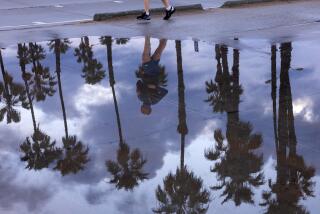Parts of Southern California haven’t seen this much rain in decades. And more is on the way
After years of drought conditions, 2019 is shaping up to be a winter to remember.
Rain totals are well above normal, and this week’s storms brought some records. From Palm Springs to parts of San Diego County, communities recorded some of the wettest days in years, in some cases in decades.
Downtown L.A. getting wet
Downtown Los Angeles saw 2.12 inches of rain in the 24-hour period that ended at midnight Friday. The area has seen 15.5 inches of rain this water year, which began Oct. 1, surpassing the average for the entire year of 14.93 inches. This represents the region getting 173% of average precipitation for this time of year. Typically, the downtown area sees less than 9 inches in that time frame.
Surprising but not really unusual
With 14 of the last 20 water years — prior to this year — having been drier than average, forecasters say it’s not unusual for recent rainfall to surprise Californians.
“We’ve been lulled into a new normal with so much drought in the last several years,” said Miguel Miller, a meteorologist with the National Weather Service. “Now when it does rain normally it seems like a lot. We’re not on a record pace, but we are definitely well above average.”
The wettest day in decades in some areas
The storm Thursday dropped more than 10 inches of rain on Palomar Mountain, more than 6 inches in Julian and close to 3.5 inches in Oceanside.
The system produced one of the wettest winter days in decades, breaking daily rainfall records in seven communities, including Palomar. The mountain received 10.10 inches, snapping the record of 9.58 inches, set Feb. 14, 1991. Ramona got 4.05 inches, nearly 2 inches higher than a record set in 1995.
The winds were just as daunting, gusting to nearly 80 mph south of Julian and more than 40 mph at San Diego International Airport, where controllers had pilots take off to the east to take advantage of the lift.
A weather balloon tells the story
A weather balloon released from Miramar Marine Corps Air Station at 4 a.m. Thursday “showed the highest level of precipitable water in the atmosphere, for winter, since 1948,” said Matt Moreland, meteorologist in charge of the National Weather Service office in Rancho Bernardo.
He said the balloon measured the equivalent of 1.68 inches of rain in the column of air it traveled though. By comparison, the atmosphere typically has about 1.2 inches of water during a humid day in summer.
More to Read
Start your day right
Sign up for Essential California for news, features and recommendations from the L.A. Times and beyond in your inbox six days a week.
You may occasionally receive promotional content from the Los Angeles Times.







